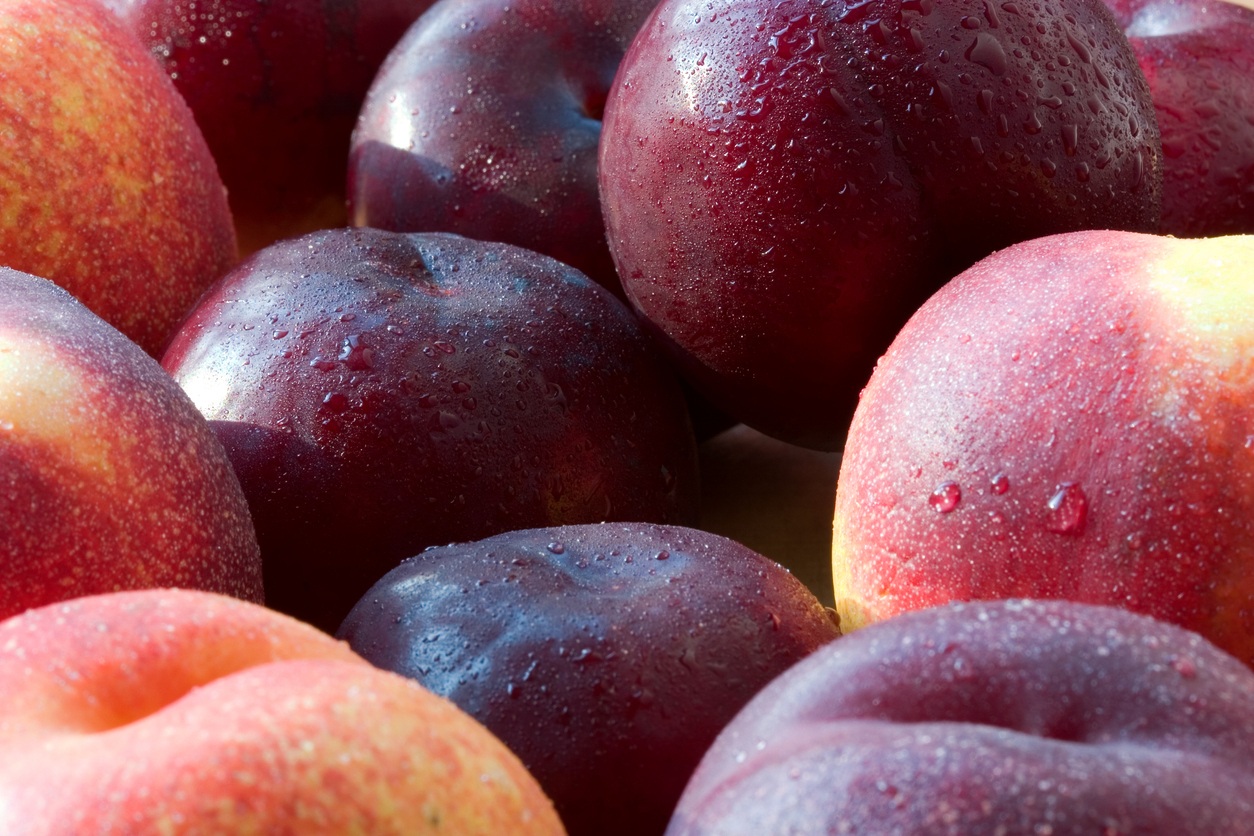The sun is shining, the birds are singing, and stone fruit has finally returned to Oliver’s! We look forward to stone fruit season every year, but this year, we’ve got even more to celebrate because Nick Boldt’s stone fruit is officially certified organic! With this deliciously good news and a bevvy of succulent stone fruit to choose from, Oliver’s is sure to have the right stone fruit to make you say “YUM”.
Here are 7 varieties to check out this season – try one, or try them all!
Yellow & White Peaches
Peaches are arguably one of the most popular stone fruits, and for good reason! At their peak, these guys are sweet with just a hint of tartness, making them perfect for pies, cobbler, canning, and fresh salads. White peaches taste essentially the same as their yellow sisters, the only difference being that white peaches are usually derived from Asian peach varieties. There are many sub-categories of peaches, but the main difference between them is whether they are freestone or clingstone. These names are fairly self-explanatory – freestone peaches have a pit that is not attached to the flesh of the fruit, while clingstones are attached. While freestone peaches are typically juicier and definitely easier to eat, clingstones tend to be just a little bit sweeter! Peaches will continue to soften as they sit out, but they won’t get any sweeter than when they were picked. While they are less well-known for their health benefits than for their taste, peaches have been shown to help treat and prevent kidney stones. Check out our recipe for Grilled Peach Crostini to get started!
Yellow & White Nectarines
Lacking the fuzzy skin of their peach cousins, nectarines are intensely sweet with just hint of spice on the aftertaste, but be warned – an underripe nectarine tends to be a bit bitter. A ripe nectarine will have a sweet scent and just a slight amount of give when squeezed (check out our handy guide to picking stone fruit HERE). Technically, nectarines are actually just peaches that lack the gene for fuzzy skin; however, the taste and texture are different enough that they are treated as different fruits. Nectarines are known for being slightly smaller than peaches but infinitely sweeter and more fragrant; they’re delicious fresh, but throw them on a grill or bake them into a pie and you’ll be in for a truly wonderful experience. Look for nectarines with a deep red blush and no bruising or damage spots. Use them in our recipe for Pork Chops with a Nectarine Chili Glaze!
Red & Rainier Cherries
Who knew super-foods could be so dang tasty? These tiny health-bombs are packed with essential nutrients that help to boost your overall health and prevent future health problems. They’re chockablock full of antioxidants, Vitamin C, fiber, and even melatonin; they’ve been shown to improve sleep, help with all manners of inflammation, lower cholesterol, reduce the risk of heart disease, protect against diabetes, and help treat and prevent attacks of gout. Try them as a colorful addition to a summer fruit salad or simply snack on them as often as you like – either way, you’ll be reaping tons of health benefits at less than 100 calories per serving! You can also snack on them as an post-workout treat to help prevent sore muscles, or as a pre-bedtime snack to help you get the most from your sleep. Try them as a colorful addition to this Cherry and Goat Cheese Salad, or bake up a batch of this Black Forest Brownies.
Pluots
Is it plum, is it an apricot? Nope, it’s a pluot! Pluots are a hybrid of both plums and apricots that are 75% plum to 25% apricot. They’ve got the look of a plum, being small and round with smooth skin, but the skin itself is a dappled blend of a bright red, orange, and yellow. As with nectarines, you want to look for particularly bright specimens, as these will lend the sweetest flavor; the flesh is pink, firm, and juicy. As a result, these pretty fruits make for baked goods that are as beautiful to look at as they are delectable to eat. They lack the bitterness that can sometimes spoil a plum and don’t run the same risk of becoming mealy as an apricot, making pluots truly the best of both worlds! Enjoy them fresh, or cook them up like in this Braised Chicken with Pluots and Thyme.
Apricots
Apricots have been enjoyed worldwide for centuries, and you only need try one for yourself to understand why – these sweet little nuggets of joy are perfect for snacking! Dried, canned, cooked, there’s really no wrong way to savor an apricot, and they’re ridiculously healthy to boot. They’re typically small, with a fuzzy skin similar to a peach and yellow-orange to bright orange color. The flesh is firm and juicy, though sometimes they can become mealy if they’re left too long in the cold. Apricots contain iron, manganese, phosphorus, calcium, and other nutrients vital to bone growth, making them great for supporting healthy bones as we age. They also contain high amounts of potassium and antioxidants, both of which are necessary for maintaining heart and metabolic health. Finally, apricot oil is fantastic for the skin and has even been shown to help with earaches and asthma! Add them to recipes like this Summer Stone Fruit Streudel, or simply savor them fresh.
Donut Peaches
Donut peaches (also known as Saturn peaches) have been getting a lot of media hype recently, and it’s no wonder when you have a fruit that’s so adorable and delicious. A common misconception is that they’ve been bred to be in their particular flat shape, but that is in fact false! Donut peaches are actually descendants of an ancient species of wild peach known as pan tao. These peaches first made the journey from China to the USA nearly 150 years ago, but it wasn’t until the 1980’s that they began to become commercially available. These days, donut peaches are enjoyed for their intense sweetness and have diversified to meet all manner of flat peach-related desires. The standard donut peach is small in stature with slightly fuzzy, pink skin; the pit is easy to remove, making these peaches great for snacking on, and the flavor is deeply peachy. Unfortunately, they’re prone to damage as well as disease, so they tend to be a little pricier than your standard peach, but trust us – they are well worth it!
Plums
Little Jack Horner had the right idea when he started fishing around for plums with his thumbs – these beauties are the ultimate summertime treat! Like other stone fruit, they’re low in calories and are packed to bursting with fiber. They range from tart to sweet in flavor, and the color of the flesh can vary from pure yellow to deep red. This distinctive red color also gives them health properties that are not present in yellow-fleshed plums. The red flesh is packed with a particular group of antioxidants called anthocyanins; these anthocyanins are responsible for the red, blue, purple, and black hues of well-known health foods like blueberries and kidney beans. Their benefits include supporting heart health, weight management, diabetes management, and eye health, and anthocyanins have even been linked to cancer prevention. Red plums are also packed with various vitamins and minerals, lending them even more clout as a health food! Their tartness can sometimes make them a little difficult to eat raw, but cook them down and you’ll get to experience the true range of flavor contained within a plum.
So you see, no matter what kind of stone fruit you’re in the mood for, Oliver’s has everything you need to get your summer fruit fix! This week, stop in for unbeatable prices on the freshest stone fruit available – whether it’s a peach or a pluot, you’re sure to find deals that are perfectly peachy keen!


No comments yet. Add the first comment